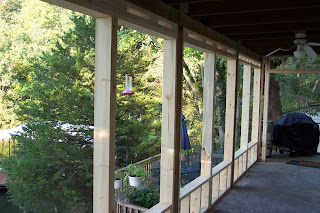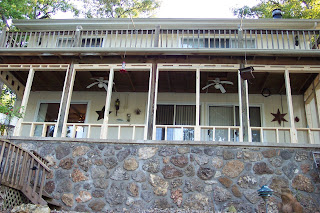In a previous post, I discussed the
planning and decision-making process for our lake home addition. Having made the decision, I was now ready to begin the actual work. Plan in hand, I headed to the lake for an extended weekend of solitary work.
 |
The old framework was in good shape, but didn't have the look we wanted for the addition. The old
6 x 6 support beams would stay in place. |
The old porch had a 2 X 4 framework that held the screens in place. While this framework was in good condition, it was inadequate for my needs. Specifically, it had a few things that made it necessary to do a complete tear-out:
- Since the support beams were 6 X 6's, the smaller framework would need to be shimmed out to match the beams - a very labor-intensive process.
- The rough openings weren't exactly what I needed for the windows and doors.
- The openings weren't solid enough to provide a good mounting platform for the windows and doors.
Armed with a crowbar, hammer, and driver drill, I began tearing things down. We weren't going to reuse anything, including the old doors, so I pulled those out and hauled them to the top of the hill. Initially, I was going to save the old lumber, but I soon decided it was more work than it was worth to remove all the nail, so I ended up just ripping it apart and piling it up, nails and all. After the framework was gone, I pulled out some of the old electrical and fixtures, leaving some lights for the moment. After about a half day, I was ready to start building!
A couple of things have changed since I last did any major construction project. I had never used a
pneumatic nail gun - I don't even know if they existed way back in the stone ages when I helped my father build or remodel. Fortunately, Carter owns several nail guns, and she was kind enough to loan them to me for the duration of the project. I soon discovered that these things are real labor savers! You also have the ability to quickly drive nails at odd angles. The downside? You have to use some restraint, or you'll end up with more nails than board.
I ended up cutting all the framing lumber with a circular saw - hand measuring each board, marking it with a square, and following the line with the saw. I'm pretty good with a circular saw, but, if I had it to do over again, I'd have bought a
power miter saw, and used it to cut the 2 X 6 framing. Ironically, I ended up buying a big saw for the trim work, not realizing it would have been perfect for the framing. In any case, I cut all the framing with the circular saw, with no real problems.
Since I wanted the maximum glass area, my windows were custom sized. The rough opening for each window was slightly larger than the frame size, to leave you enough room to level the windows. I tried to get each opening as square, plumb, and level as possible to reduce issues when installing the windows.
 |
| Rough openings are an inch or so larger than the window frames |
 |
| I also framed out an opening for the walk-in door and through-wall heat pump in the far end. |
 |
| You can see the detail, including the "cripple" studs around the openings. Since the support beams provide adequate strength, I didn't have to worry about structural strength of the headers. |
 |
| The other end is framed for the sliding patio door. |
 |
| The view from the outside - Still not much difference! |
After framing, the next step was to add the sheathing. Fortunately, Carter was able to come down to help with sheathing and window and door installation. Sheathing adds rigidity to the structure, gives it lateral stability, and provides a smooth, solid surface. Depending on the application, sheathing can be fiber board, foam board, or (my choice) OSB.
OSB (Oriented Strand Board) is a plywood-like material - we used to call it "chip board" - less expensive than plywood, providing a more solid, secure sheathing than foam. Since I was planning on vinyl siding, I wanted to have a "real wall" - something that would withstand at least a little force before breaking down. Adding foam board to the outside would provide superior insulation, but I elected not to use it for this project - the wall was almost completely glass anyway, so I didn't think it would be worth messing with. I would, however, insulate the wall cavities, as well as the ceiling.
Protection from water intrusion is of primary importance in any home. Years ago, I can remember using tar paper or "builders paper" over the sheathing to protect against water. Now, you use
House wrap. I used Tyvek brand - a leading product in the industry. Tyvek stops wind and water from coming in, while still allowing water vapor to pass through from inside the house. We installed carefully, taping the seams with the special tape made for the job. We took special care around the window openings, wrapping the Tyvek around the opening, then adding self-stick flashing to (hopefully) eliminate leaks.
 |
| Starting to look like a wall! |
 |
| House wrap added, almost ready for windows. |
 |
| The gray tape under the window is flashing - the bottom piece is installed under the window, then more is added up the sides and on top, so water from the top will end up outside, rather than in the wall. |
Once the wrap was on, we were ready for window installation. We were using "new construction" windows, meaning they came with a mounting flange attached. This simplifies installation - all you have to do is caulk, put them in the opening, shim until they're square, and nail them in. Of course, that sounds a little easier than it is!
Our windows were large and heavy, and they weren't at ground level from the outside, so we decided to install them from the inside. This required us to remove the screen and movable glass pane, and put them through the opening from the inside. Even nailing the fins - ordinarily the easy part - was more difficult due to the awkward reach required.
 |
| First window installed! |
 |
| I had to lean out the window to fasten the flanges. |
 |
| Believe it or not, I did the whole project without falling! |
 |
| Almost done! |
 |
| All the windows are in. |
Once the windows were done, we had to install the doors. The walk in door was easy - it was pre-hung - just set it in the opening, make sure it is plumb and square, shim, and you're done. The sliding door wasn't hard, but it was really heavy. Carter and I had our hands full just moving it into position! Once into position, is was a straight-forward process to level it and finish the job.
 |
| The walk-in door at the far end, seen from the outside. The small framed opening below the window is for the heat pump. |
 |
| The patio door, installed. Note the flashing around the door. |
We now had a completely enclosed room - if the weather turned cold, I could at least work on the inside. The next step was to add the vinyl siding, so the outside would be completely finished and ready for winter.
I'd never installed vinyl siding before. It's not very hard, but there are a couple of things you need to be careful of. Since vinyl expands and contracts with temperature changes, it shouldn't be fastened too tight - it must be free to move slightly. For this reason, fastener holes are slotted. It's also important to cut pieces slightly smaller than the opening, to allow for expansion.
The other thing you need to keep in mind is that the siding isn't water tight, so your fasteners need to be able to withstand exposure to the elements without rusting. Standard galvanized screws or nails won't do - when they rust, you may get stains running down the siding. Although I would have preferred to use screws, I had trouble finding stainless steel or other rust-free screws with the necessary broad, flat head. I ended up using aluminum roofing nails for the siding. Aluminum nails are very difficult to use - any slight mishit causes the soft aluminum to bend.
To get started, you first install all the trim pieces - corners and "J Channel" around windows. This trim covers the cut ends, giving you a nice, finished appearance. The siding itself goes pretty quickly - starting at the bottom, you nail it up, overlapping slightly at the seams. The next piece locks into the lower one, again making sure nothing is too tight. The top of each side slips into a special piece of trim that holds it in place.
 |
| Here you can see how the siding, trim, soffit, and fascia combine to give a finished appearance. |
 |
| The walk in door, with trim. Note the sleeve for the heat pump on the lower left side. |
 |
| Here's the look from the lake - a nice addition to our house. |
I also elected to cover the soffits and fascia with vinyl. It installs similarly to the siding, and provides a nice, clean look with very little maintenance. All in all, I was happy with the look of the room from the outside - now, I just needed to get to work inside!
Soon, I'll post about the completion of the project.







